Boston’s Beacon Hill is and always has been Boston’s most exclusive neighborhood where politicians, poets, and philanthropists among others have made their home.
It is a neighborhood that many tourists fail to explore as it can be a bit intimidating without a guide but this self-guided tour should make navigation of that neighborhood easy.
Don't forget to tag us @freetoursbyfoot when you take this tour!
You can share your photos and ask us any questions!
Click here to view larger interactive map.
This tour is also available as an audio tour!
Start your tour at the Massachusetts State House (A) at 24 Beacon Street.
This “new” State House was opened in 1798 on land that was once owned by the great patriot John Hancock.
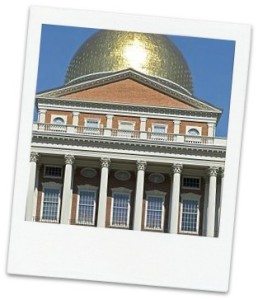
It is the oldest continually running statehouse in the United States and is still today the seat of government for the Commonwealth of Massachusetts.
The building was designed by Charles Bulfinch who designed much of the architecture you will see in the Beacon Hill Neighborhood.
Notice the 23-karat gold dome which is 30 feet high and 50 feet around. It was gilded in 1876 on our nation’s 100th birthday.
The Massachusetts State House offers free tours,
Enter through the General Joseph Hooker Entrance for a free tour of the inside of the State House.
Face the gold dome and walk left down Beacon St, to Walnut St. (about two blocks down Beacon St.). Take a right up Walnut St. and you are entering the Historic Beacon Hill Neighborhood.
All the lamp posts that you see are lit by gas. Just like they have always been.
Notice the window boxes with their arrangement of flowers. This is a very distinct part of the neighborhood.
Also if you look down at the door-stoops you will sometimes see little metal bar-like contraptions which are called boot scrapers.
These were useful in the 1800s and early 1900s as the main mode of transportation was horses.
One could scrape the horses...let’s call it exhaust, off their shoes before entering their homes. Just as practical today as in the past.
At the top of Walnut St. you will come to Mt. Vernon St. Look right for 55 Mt. Vernon St
The Nichols House Museum (B)

This structure is a great example of the Federalist style of Architecture that was a trademark design of Charles Bulfinch.
Bulfinch is considered to be the first American-born architect - many of his contemporaries were British immigrants.
He was also the third Architect of the Capitol in Washington DC.
It was built for Jonathon Mason in 1804 and welcomes visitors and provides a look into the life of Beacon Hill Residents in the 19th and 20th centuries.
Inside you'll find the original art and furnishings of the Nichols family, who purchased the house in 1885.
Rose Standish Nichols spent most of her life in this house. She was a landscape architect, peace activist, and suffragist.
In 1961, a year after her death, the historic house museum opened with items collected from the family's generations in the house.
Facing the Nichols House Museum, walk left down Mt. Vernon St. As you travel down Mt. Vernon St. notice 57 Mt. Vernon St.
57 Mt. Vernon St. (C)
This was the former residence of Daniel Webster (not the dictionary guy).
Daniel Webster was a US Senator representing Massachusetts as well as a three-time Secretary of State under three different presidents (Harrison, Tyler, and Fillmore).
He was a character in the Mark Twain story “The Devil and Daniel Webster.”
Charles Francis Adams, Sr - of the political Adams family, also lived here. His father was President John Qunicy Adams and his grandfather was President John Adams.
He served as a state senator and was the ambassador to the United Kingdom during the American Civil War.
He built the first presidential library to honor his father in Quincy, Mass. Webster is remembered for his oratory skills.
Ralph Waldo Emerson, who was a critic of Webster's political decisions, said that he was "the completest man", and that "nature had not in our days or not since Napoleon, cut out such a masterpiece.
Continue walking along Mt Vernon Street to number 65.
At 65 Mt. Vernon St. (D) just above the archway, you will notice an engraved CABOT where Henry Cabot Lodge once lived.
Henry Cabot Lodge, a Republican senator from Massachusetts, was the first unofficial Senate Majority Leader and was best known for his foreign policy disagreement over the Treaty of Versailles with President Wilson.
Lodge wanted to sign the Treaty and join the League of Nations, with reservations whereas was Wilson wanted to join with no reservations - meaning that the US could be forced into a war without approval by Congress.
In the end, the US never joined the League of Nations and it was never a successful organization.
When its successor, the United Nations, was formed, Lodge's reservations were incorporated and the US has veto power.
Continue down Mt. Vernon St. and look over at 85 Mt. Vernon St.
85 Mt. Vernon St. (E)

Here you will see the Harrison Gray Otis House, built in 1802 by Charles Bulfinch, it is the last remaining freestanding house on the Hill (everything else is condos).
It is a classic Charles Bulfinch design. Bulfinch's Federalist design includes classic features of domes, columns, and ornamentation.
Harrison Gray Otis was the third mayor of Boston, a US Congressman as well as a US Senator and member of the Federalist Party.
He was also one of the richest men in Boston at the time.
He had another house in Boston built by Charles Bulfinch at 141 Cambridge Street that is now a museum open to the public.
Continue down Mt. Vernon St. to Willow St. and Mt. Vernon St.
9 Willow Street (F)
The poet and Pulitzer Prize winner Sylvia Plath lived at 9 Willow St. in 1958.
They had moved here from Northampton and would relocate to England after so they were only in Boston for a short time.
This apartment overlooks Acorn Street, which is still considered one of the most beautiful streets in America.
Plath was married to the English poet Ted Hughes, had 2 children, but suffered from depression and committed suicide at age 30.
In 1998, Hughes, who was Britain's Poet Laureate, released a book of poetry, many of them dedicated to Plath. One of them is entitled 9 Willow Street.
"Each of us was the stake
Impaling the other. We struggled
Quietly through the streets, affirming each other
Dream-maimed and dream-blind."
Stand at the corner of Willow St. and Mt. Vernon St. and look 88 Mt. Vernon St.
88 Mt Vernon Street
Notice the plaque at 88 Mt. Vernon St. where the Poet Robert Frost lived from 1938 to 1941.
Robert Frost died 2 weeks before Sylvia Plath, at the age of 88.
He was an accomplished Pulitzer Prize winner and Congressional Gold medal holder and was asked at age 86 to read a poem at J.F. Kennedy’s Inauguration.
The most famous Frost poem is The Road Not Taken. You may be familiar with its closing line...
Two roads diverged in a wood, and I—
I took the one less traveled by,
And that has made all the difference.
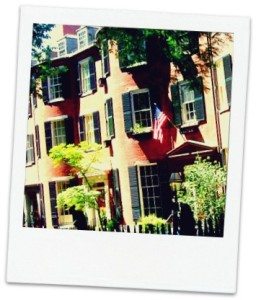
Standing in front of 88 Mt. Vernon St. is a great view of not only Boston's most exclusive section but one of the most expensive places to live in the country.
This street is called Louisburg Square (H).
It is a block of condos split in half with a private park running through the center of it.
The writer Louise May-Alcott, best known for her 1868 novel Little Women, once resided there.
At the end of the Square where you see the American Flag, is one of former US Secretary of State John Kerry's current residences.
Follow Mt. Vernon St. down to West Cedar St. Take a left onto West Cedar St. As you travel down West Cedar, notice the beautiful window boxes.
Soon you will come to Boston’s most photographed street, Acorn St. The view from the bottom looking up is the better view.
Acorn Street
The street is made up of river stones from the Charles River and is one of few streets that have their original cobblestones.
The Boston landscape was (and still is) filled with stones known as cobs.
When the city was being built up, these stones needed to be removed, and cobbling the roads turned out to be a practical use for them.
They are not fun to walk on ... or bike, drive or ride a horse on ... which is why true cobblestone streets are rare nowadays.
Follow West Cedar St. and take a right down Chestnut St. (Did you notice yet that many of the streets of Beacon Hill are named for trees?), and you will come to Charles St. the shopping district for the Hill residents.
This street is a quaint street dotted with antique shops, restaurants, and boutiques.
Take a left on Charles St. and follow to end (about a block) and you are back on Beacon St.
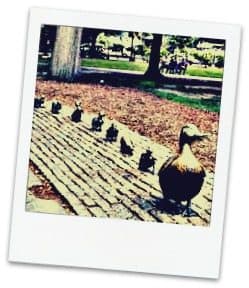
Take a right on Beacon St. Take a short detour and cross Beacon St. and enter the Public Garden.
You will come to a statue of recognizing the children’s story Make Way For Ducklings (I) where a row of baby ducks are following their mom.
You can sit on the ducks and take a photo if you like.
Exit the Public Garden back through the gates and you will be back on Beacon Street.
Cross back to the corner of Charles and Beacon Sreet and follow Beacon Street to number 84 where you will come to the Bull & Finch Pub (Charles Bullfinch)
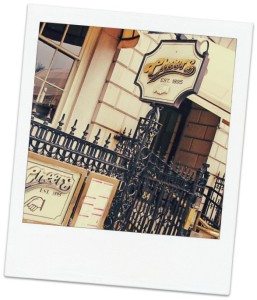
This bar is known as Cheers (J), where everyone knows your name.
The original pub was founded in 1969. The exterior is recognized around the country as the opening shot in the TV show Cheers.
Grab yourself a drink and/or a famous “Norm Burger.”
Read our full post on how to visit the Cheers Bar.
After you exit Cheers, take a left on Beacon Street back to Charles Street Stroll down Charles Street, and check out the many shops and cafés.
Notice the Paramount at 44 Charles Street (K) a good place for breakfast or lunch and our next stop.
Look up at the residences on top of the restaurant, the second-floor apartment was where a woman named Mary Sullivan lived.
She was the last and at 19 years old the youngest victim of Albert DeSalvo "The Boston Strangler." Her body was found in that apartment on January 4, 1964, at about 6:00 pm by her roommates Patrica and Pamela.
Mary just moved in three days earlier. Her body was displayed in a seated position with three ligatures around her neck - a charcoal nylon stocking, a pink scarf, and a pink and white scarf with a floral design.
All three were tied in a bow (a signature of the Boston Strangler).
The killer also placed a card leaning on Mary's left foot, addressed to the Boston Police that read "Happy New Year!" This was the only crime scene where the Boston Strangler left a note.
Also, the Boston Strangler never brought any items which he used to strangle his victims. All items were found by the killer inside the victim's residence and used to strangle them.
Follow Charles Street to 70 Charles Street to the Charles Street Meeting House (L) (1804)
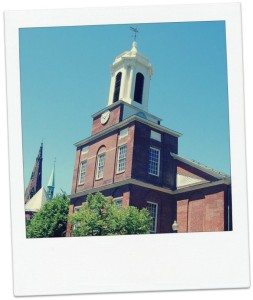
The Charles Street Meeting House was designed by Asher Benjamin, who also designed many famous structures in Boston including the African Meeting House (1806) and also helped with the planning of Quincy Market (1826).
As were most churches in the early 19th century, this church was segregated and black Americans could only sit in the upper gallery. In 1836, one of the members of the church, Timothy Gilbert invited several black members of the church to sit with him in his personal pew and was promptly kicked out.
He would go on to found the first integrated church in America. Despite this start, The Charles St. Meeting House was a major player in Boston’s Abolitionist movement and saw speakers like William Lloyd Garrison, Fredrick Douglass, Sojourner Truth, and Charles Sumner.
It was then sold and became the Charleston Street African Methodist Episcopal Church, the largest of the black churches in Boston after the Civil War. They left in 1939.
Today most of the exterior is preserved in its original historic form, though the interior has been developed for commercial and private use.
Take a quick trip down Mt. Vernon St. to 130 Mt. Vernon St. and you will see the Sunflower House (M).
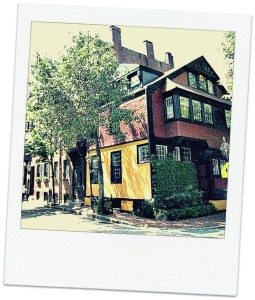
This area is known as the Beacon Hill Flat. It used to be part of the Charles River and filling it in was one of the earliest land-making projects in Boston when it began in 1803. The land you're standing on used to be the top of nearby Mount Vernon.
This was the part of Beacon Hill where you would find the stables (and later garages) of the larger homes up the hill. It was home to blacksmiths and stable workers but as Boston developed, these working homes and stables would later be turned into apartments and artists' studios.
This particular home was built in the 1840s and stands out in a neighborhood of federal-style homes.
This was the former home of artist Frank Hill Smith, who painted the ceiling frescoes in the Representatives Hall of the Massachusetts State House. When he lived there it was a simple wooden structure.
In 1878, it was renovated to a Queen Anne style. American Queen Anne architecture often features overhangs, asymmetry, and differing wall textures.
In 1904, the artist Gertrude Beals and her husband Frank Bourne moved into the home. She was a well-known watercolor artist and her studio was located on the third floor. One of her paintings was of her in-home studio. Titled “The Artist’s Studio – Sunflower Castle, it is now in the collection of Historic New England.
Notice the sunflower above the second-floor window where it gets its name. This 3,200 square-foot house was listed in the market for $4.6 million in 2012.
Back on Charles St., continue your stroll to the end of Charles St. and you will see the Charles/MGH Subway Station (N). Cross under the Station to the other side you will be outside the former Charles Street Jail.
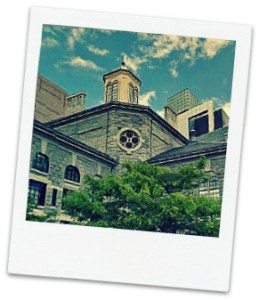
Former Charles Street Jail (O)
This was was the jail for Suffolk County from 1851 to 1990. Some of the inmates include former Boston Mayor James Michael Curly, Malcolm X, and Sacco and Vanzetti to name just a few.
The jail was forced to close in 1973 by federal court order as overcrowding violated prisoner rights and was finally shut down in 1990. The building, designed by Gridley James Fox Bryant in 1851, was built with a 90-foot octagonal rotunda with jail wings stretching out in a cross that allowed segregation of prisoners by the class of crime.
It was designed according to a 1790s humanitarian plan for prison reform known as the Auburn Plan. The Auburn Plan, among other reforms, called for designated areas for prisoners to work and exercise along with individual cells.
It is now a luxury hotel with plush lounges. There are two lounges and a restaurant inside with jail themes. The lounges are named The Clink and Alibi's and the Italian restaurant is called Scampo’s. Alibi’s is the former drunk tank and guests can enjoy a beverage behind steel bars view mug shots of celebrities like Frank Sinatra, Mickey Rourke, and Lindsay Lohan.
Once you exit the Liberty Hotel, you can jump on the Subway (Redline Stop Charles MGH) one stop back to The Boston Common or walk back down Charles St. to Beacon St. and the Boston Common (it's about a 15 minute walk).








